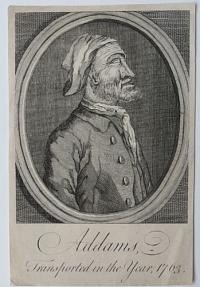
Addams, Transported in the Year, 1763.
[n.d. c.1770.]
Engraving. 196 x 127mm (7½ x 5"). Slight creasing.
Portrait of Addams (fl.1763), a bearded convict. Transported to the American Plantations. BM No: 1999-0926.7
[Ref: 29565] £130.00
(£156.00 incl.VAT)
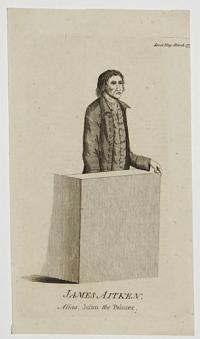
James Aiten. Alias John the Painter.
Lond. Mag. March 177[7].
Engraving. Sheet 215 x 120mm (8½ x 4¾"). Trimmed into date on right.
James or John Aitkin (1752-77), a Scot better known as John the Painter, shown in the dock during his trial for arson attacks on British dockyards during the American War of Independence. A painter by trade, his knowledge of chemicals paint solvents enabled him to make crude incendiary devices. After attacking Portsmouth and Bristol Dockyards, causing a general panic of a large band of arsonists, he was captured, tried and hung at Portsmouth on 10th March 1777. The mizzenmast of HMS Arethusa was taken from the ship and erected at the dockyard entrance, so that the reported 20,000 spectators could all get a good view. It was the highest gallows ever to be used in an execution in England.
[Ref: 40942] £120.00
(£144.00 incl.VAT)

Old Aldridge of Eddington. Twice tried before F. Burton Esq. at Oxford for assaulting a Young Lady of that City.
Publish'd May 7, 1787. by I.F. Bryant, No. 35, Long Acre.
Etching with aquatint, image 132 x 94mm. Trimmed to plate and tipped into album page.
Ex: Collection of The Hon. C. Lennox-Boyd.
[Ref: 7557] £170.00
(£204.00 incl.VAT)
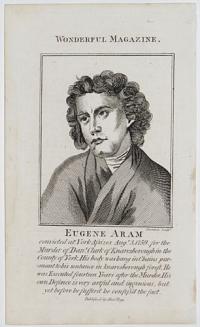
Eugene Aram convicted at York Assizes Aug.t 3 1759 for the Murder of Dan.l Clark of Knaresborough in the County of York [...]
Thornton Sculpt
Published by Alexr Hogg.
Rare engraving with 10pp letterpress, sheets 210 x 130mm (8¼ x 5"). Trimmed to platemark.
Eugene Aram (d.1759), murderer and philologist, with extensive letterpress biography, as published in the 'Wonderful Magazine', which specialised in stories of eccentric and remarkable individuals. Aram was a considerably learned man, self-taught for the most part, who worked as a schoolteacher for much of his life. In 1758 the discovery of what was believed to be the skeleton of Daniel Clarke, a shoemaker from Knaresborough who disappeared in 1745 shortly after coming into money, led to Aram being named as an accomplice to Clarke's murder. Aram was tried in York in 1759, and he and the other defendant, a linen weaver named Houseman, accused each other. All of the evidence was circumstantial and Houseman turned crown's evidence in return for acquittal. Aram defended himself, and the letterpress to this print quotes Aram's speech, with its philosophic argument against the circumstantial evidence. Nevertheless a conviction was obtained and Aram was hanged at Knavesmire in 1759. The letterpress concludes by wondering how 'a man with abilities so superior, could think of embruing his hands in the blood of a fellow-creature'. While Aram's achievements as a linguist have subsequently been discredited, he was to be immortalized in Thomas Hood's ballad 'The Dream of Eugene Aram' (1829) and Edward Bulwer's eponymous novel of 1832.
[Ref: 39624] £95.00
(£114.00 incl.VAT)
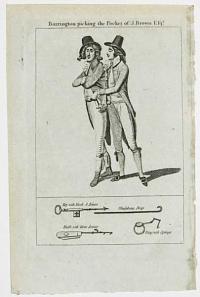
Barrington picking the Pocket of J. Brown Esq.r.
[n.d., c.1790.]
Engraving. Plate: 165 x 110mm (6½ x 4¼''). Small margins.
A scene showing pickpocket George Barrington (1755-1804) picking a pocket, below are various aparatus for stealing. George Barrington was a socialite who was convicted for stealing in 1790 and transported to Botany Bay. On his journey to Australia he alerted the captain to a plan to seize the ship, on their arrival the captain reported his actions to the authorities and he received a warrant of emancipation, he later became high constable of Parramatta.
[Ref: 51117] £160.00
(£192.00 incl.VAT)
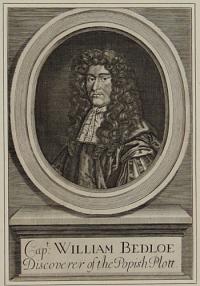
Cap.t William Bedloe Discoverer of the Popish Plott.
[Anon., c.1681]
Engraving, sheet 215 x 145mm (8½ x 5¾"). Trimmed. Glued to album sheet at edges.
William Bedloe (1650-80), informer and adventurer. In the 1670s Bedloe fell into a life of crime in London, spending time in jail for fraud and at one point fleeing for the continent with his brother. There they stole horses and committed fraud, going by different disguises and identities. In Valladolid they met Titus Oates (and stole from him too), but back in England Bedloe came into the public eye following the death of Sir Edmund Berry Godfrey. Godfrey died in mysterious circumstances soon after receiving testimony from Oates about a supposed 'Popish Plot' to assassinate Charles II, and Bedloe claimed he knew how Godfrey had died. Bedloe appeared at a number of trials relating to the plot, giving evidence that led to the deaths of a number of innocent people. An opportunist, Bedloe exploited the hysteria and gullibility surrounding the fabricated plot, earning well from his 'evidence', while his early death meant he was spared the retribution which Oates and others received once the smoke cleared.
[Ref: 42812] £190.00
(£228.00 incl.VAT)
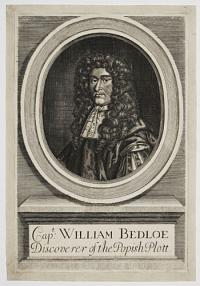
Cap.t William Bedloe Discoverer of the Popish Plott.
[Anon., c.1681]
Engraving, rich impression. Sheet 225 x 150mm (9 x 6'').
William Bedloe (1650-80), informer and adventurer. In the 1670s Bedloe fell into a life of crime in London, spending time in jail for fraud and at one point fleeing for the continent with his brother. There they stole horses and committed fraud, going by different disguises and identities. In Valladolid they met Titus Oates (and stole from him too), but back in England Bedloe came into the public eye following the death of Sir Edmund Berry Godfrey. Godfrey died in mysterious circumstances soon after receiving testimony from Oates about a supposed 'Popish Plot' to assassinate Charles II, and Bedloe claimed he knew how Godfrey had died. Bedloe appeared at a number of trials relating to the plot, giving evidence that led to the deaths of a number of innocent people. An opportunist, Bedloe exploited the hysteria and gullibility surrounding the fabricated plot, earning well from his 'evidence', while his early death meant he was spared the retribution which Oates and others received once the smoke cleared.
[Ref: 48804] £160.00
(£192.00 incl.VAT)
![[Rachel Belaney] The Wife of J.C. Belany, of North Sunderland.](img-thumbnail/jpegs/62116.jpg)
[Rachel Belaney] The Wife of J.C. Belany, of North Sunderland. Mrs. B. died in London on the 8th Day of June 1844, from the effects of Prussic Acid, supposed to have been administered by her husband, and for whicj he was tried at the Central Criminal Court in London, August 21 and 22 of the same year, and acquitted.
Published by William Garret, Bookseller, Newcastle [n.d., c.1842].
Wood engraved silhouette portrait and facsimile text. Sheet 255 x 195mm (10 x 8¾"). Paper toned and spotted, mounted on album paper at corners.
Rachel Belaney (née Skelly, 1823-44) married James Cockburn Belaney, who claimed to be a doctor, in 1843. The pair initially lived with Rachel's mother, a wealthy woman with interests in local mines, but she soon died with James stating that she had died from a 'billious fever', leaving her estate to Rachel. The couple then moved to London, where Rachel also died, with Belaney the beneficiary of her will. The coroner declared the death murder, with Belaney becoming the prime suspect. Despite giving contradictory evidence during the trial, Belaney was acquitted, after which he disappeared.
[Ref: 62116] £140.00
(£168.00 incl.VAT)
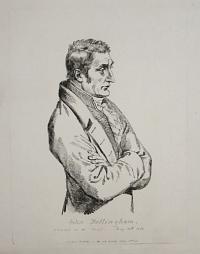
John Bellingham. Sketched at his Trial, May 15th 1812.
[after George Dance.]
London, Published as the act Directs, May 12th 1812.
A rare crayon-manner etching. 325 x 240mm (12¾ x 9½"), with very large margins. Uncut
A sketch of John Bellingham (1770-1812), in the dock at the Old Bailey for the murder of Spencer Perceval (1762-1812), the only British prime minister to be assassinated while in office. Provenance: Edge Hall Library, Cheshire
[Ref: 46549] £260.00
(£312.00 incl.VAT)
![[John Bellingham?]](img-thumbnail/jpegs/47884.jpg)
[John Bellingham?]
[n.d., c.1812.]
A rare etching. Sheet: 205 x 130mm (8 x 5"). Trimmed.
A portrait of a man in profile, perhaps John Bellingham (1771-1812) who assassinated the Prime Minister Spencer Percival in 1812.
[Ref: 47884] £140.00
(£168.00 incl.VAT)
![[Joseph Blake, highwayman] Blake, alias Blueskin, attempting to cut the Throat of Jonathan Wild,](img-thumbnail/jpegs/62100.jpg)
[Joseph Blake, highwayman] Blake, alias Blueskin, attempting to cut the Throat of Jonathan Wild, on the leads before the Sessions House in the Old Bailey. Engrav'd for the Tyburn Chronicle.
Record sculp [after Samuel Wale].
[n.d., 1768.]
Etching with engraving. Sheet 190 x 110mm (7½ x 4¼"). Trimmed within plate, stains.
Joseph "Blueskin" Blake (1700-24), thief and highwayman (as partner of Jack Sheppard), slashing the throat of 'Thief-Taker General' Jonathan Wild while in irons. Blake had been recruited to a life of crime by Wild, who operated on both sides of the law. The attack was prompted by Wild refusing to put in a good word for Blake at his trial. Blake was convicted and hung, but his act started the decline of Wild's grip over his criminal empire; Wild was hung the following year.
[Ref: 62100] £60.00
(£72.00 incl.VAT)

Miss Mary Blandy In Oxford Castle Goal, charged with the Cruel Murder of her Father, Mr Francis Blandy, late of Henley upon Thames in Oxfordshire, by Puting Poison into his Water Gruel, 1751.
[n.d., c.1752]
Rare engraving. Sheet 200 x 145mm (8 x 5¾"). Trimmed within plate, hole in image on table.
Mary Blandy (c.1718-52) taking tea with another woman before a roaring fire. She was found guilty of murdering her father with arsenic, after he refused to consent to her marrying Captain William Henry Cranstoun. She claimed Cranstoun, who was already married, had told her it was a love potion that would make her father change his mind; he fled to France to avoid prosecution. She was hanged outside Oxford Prison. Expert testimony about presence of arsenic was provided by Dr Anthony Addington, father of the Tory Prime Minister, Henry Addington.
[Ref: 62094] £160.00
(£192.00 incl.VAT)
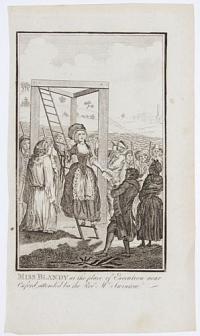
Miss Blandy at the place of Execution near Oxford attended by the Rev.d Mr Swinton
[Anon., c.1760]
Engraving, sheet 210 x 125mm (8¼ x 5").
Mary Blandy (1718/9-1752), murderer, ascending the ladder to her execution. Blandy was found guilty of murdering her father by poisoning him, after he refused to consent to her marrying Captain William Henry Cranstoun. Cranstoun, who many believed the real villain, fled to France to avoid prosecution.
[Ref: 45471] £70.00
(£84.00 incl.VAT)
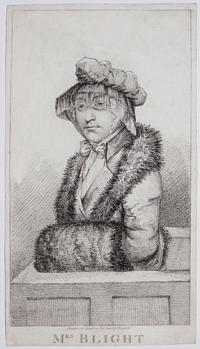
Mrs Blight.
Drawn on purpose by George Simpson.
[?London. Published April 12th 1806 by Jeffery, Pall Mall.]
Stipple, rare. Sheet 200 x 110mm (8 x 4¼"). Trimmed within plate, losing publisher's inscription.
Portrait taken during a famous murder trial at the Session House, Newington. Richard Patch was accused of shooting Isaac Blight, his former master. Such was the interest in the case that special accomodation was made for two sons of George III to attend, the Dukes of Cumberland and Sussex. Patch was found guilty and was sentenced to death & dissection. A full account of the trial was also published. For Simpson's portrait of the murderer see 13585.
[Ref: 44302] £60.00
(£72.00 incl.VAT)
![[Thomas Blood] Coll' Blood.](img-thumbnail/jpegs/62420.jpg)
[Thomas Blood] Coll' Blood.
[engraved by George White.]
[n.d. c.1750.] But later.
Mezzotint. Sheet 250 x 185mm (9¾ x 7¼"). Trimmed just within plate, laid on album paper.
Thomas Blood (1618-80) was an Irish-born Colonel who was famed for his attempt to steal the Crown Jewels of England from the Tower of London in 1671. He was also implicated in an attempted kidnapping and murder of the Duke of Ormonde. During the Wars of the Three Kingdoms he switched allegiances from Royalist to Roundhead but won the favour of the Court of King Charles II and succeeded in eventually dying of natural causes. CS 5, state ii of ii, with inscriptions removed.
[Ref: 62420] £160.00
(£192.00 incl.VAT)

James Bolland.
[n.d., c.1772.]
Stipple engraving with etching, 112 x 102mm.
James Bolland (c.1727–1772), sheriff's officer and forger, executed at Tyburn. From a contemporary magazine.
[Ref: 7741] £40.00
(£48.00 incl.VAT)

James Bolland, Executed for Forgery.
[Anon., c.1772]
Engraving, platemark 170 x 110mm (6¾ x 4¼"). Large margins on 3 sides.
James Bolland (c.1727-1772), sheriff's officer and forger. After having committed various crimes in his past, including hiding debtors and illegal seizure of property, Bolland was arrested for forgery in 1771, tried at the Old Bailey, and hanged at Tyburn on 18 March 1772. Engraving published in the 'Tyburn Chronicle'. For another likeness see ref. 7741.
[Ref: 46571] £65.00
(£78.00 incl.VAT)
![[Forger] The Celebrated James Bolland.](img-thumbnail/jpegs/62103.jpg)
[Forger] The Celebrated James Bolland.
`
[n.d., c.1772.]
Engraving. 175 x 115mm (6¾ x 4½"). Wormhole in edge of plate top left.
Full-length portrait of James Bolland (c.1727-72), standing before a slaughtered cow and sheep. The son of a butcher, he opened his own shop but it failed. He then became a sheriff's officer, but used the post to commit various crimes, including hiding debtors and illegal seizure of property. Eventually Bolland was arrested for forging the endorsement of a bill of exchange for one hundred pounds, tried at the Old Bailey, and hanged at Tyburn on 18 March 1772.
[Ref: 62103] £65.00
(£78.00 incl.VAT)
![[Mode of punishment by Branding, or burning of the Hand, at the New Sessions House.]](img-thumbnail/jpegs/62101.jpg)
[Mode of punishment by Branding, or burning of the Hand, at the New Sessions House.]
[Dodd delin. White sculp.]
[n.d., c.1780.]
Etching, proof before letters. Sheet 180 x 110mm (7 x 4¼"). Trimmed within plate. Foxing.
An illustration from the 'Malefactors Register, or, a Tyburn and Newgate Calendar'.
[Ref: 62101] £65.00
(£78.00 incl.VAT)
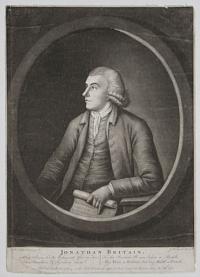
Jonathan Britain. What Villains Set the Portsmouth Yard on Fire? / Twas Jonathan & Co by whose desire? / For due Rewards Ill own, before a Bench, / My Name is Britain, but my Heart is French.
T.Parkinson ad vivum del. J.R.Smith Fecit.
Publish'd by Wm Humphrey, at the Shell Warehouse, opposite Cecil Court, St Martin's Lane, Novr. 20th 1771.
Mezzotint, lettered state, very scarce; 350 x 250mm. 13¾ x 9¾". Creased and rubbed, with scruffy extremities.
Portrait of Jonathan Britain, forger and informer; half-length, three-quarter to left, resting his left elbow on a table and holding a scroll on which can be read the title of the newspaper 'The Whisperer'; in oval frame. Britain confessed when brought to trial in 1771, for forging bills, that he was concerned in setting fire to the Portsmouth docks, naming others of high rank as conspirators, but his statements were not believed. Thomas Parkinson (1744-1789?). D'Oench 11. Chaloner Smith 24, II. Frankau 46, III.
[Ref: 27211] £160.00
(£192.00 incl.VAT)
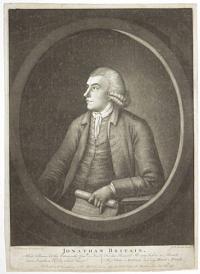
Jonathan Britain. What villains set the Portsmouth Yard on Fire...
T. Parkinson ad vivam del. J.R. Smith Fecit.
Publish'd by W.m Humphrey, at the Shell Warehouse, opposite Cecil Court, S.t Martins Lane, Nov.r 20.th 1771.
Mezzotint. Plate: 350 x 250mm (13¾ x 9¾"). Repaired tears, margins messy.
A portrait of the criminal Jonathan Britain who was executed for forgery in 1772. Having commited forgery he wrote several letters claiming responsibilty for a fire in Portsmouth and requested a pardon in return for surrendering himself and his accomplices, this was disregarded and he was arrested for his crimes.
[Ref: 46470] £140.00
(£168.00 incl.VAT)

Elizabeth Brownrigg, Executed Septr. 14th. 1767. for ye Murder. of Mary Clifford.
[n.d., c.1770.]
Engraving, image 170 x 112mm. Margin missing above and left.
Elizabeth Brownrigg d. 1767, murderess, was the wife of James Brownrigg, a house painter, who lived at Fleur de Luce Court, Fetter Lane. For some years she practised midwifery, and about 1765 was appointed by the overseers of St. Dunstan's in the West to act as midwife to the poor women of the parish workhouse. She had three apprentices, Mary Mitchell, Mary Jones, and Mary Clifford, all of whom she treated in a most inhuman manner. On 3 Aug. Clifford was found in a dying state, hidden in Brownrigg's premises, and died shortly after. James, the husband, was committed for trial. Elizabeth and her son John fled, but were apprehended on the 16th. Elizabeth was tried at the Old Bailey, before Mr. Justice Hewitt, on 12 Sept. 1767, found guilty, and received sentence. Her husband and son were acquitted. It appears that after practising all sorts of diabolical cruelties upon Clifford, the woman Brownrigg tied her up to a hook fixed in one of the beams in the kitchen, and flogged her no less than five times on 31 July. She was hanged at Tyburn on 14 Sept. 1767. Her skeleton was exposed in a niche at Surgeons' Hall in the Old Bailey, ‘that the heinousness of her cruelty might make the more lasting impression on the minds of the spectators’ (Gent. Mag.). A well-known reference to her crime is made in some verses in the ‘Anti-Jacobin. For the Gentleman's Magazine.
[Ref: 7746] £45.00
(£54.00 incl.VAT)
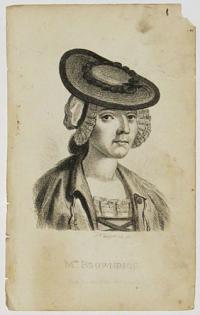
Mrs. Brownrigg.
J. Chapman sc.
Published Feb. 1801 [?] by James Cundee.
Stipple. Sheet size: 140 x 85mm (5½ x 3¼"). Trimmed inside plate. Slight loss top right.
Elizabeth Brownrigg (1720 – 1767) was an 18th-century English murderer. Her victim, Mary Clifford, was one of her domestic servants. As a result of witness testimony and medical evidence at her trial, Brownrigg was hanged at Tyburn on 13 September 1767. A plate from 'The Criminal Recorder; or, Biographical Sketches of Notorious Public Characters', printed and published by James Cundee, Ivy Lane, London.
[Ref: 38040] £45.00
(£54.00 incl.VAT)
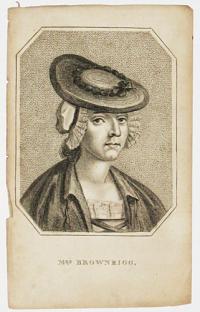
Mrs. Brownrigg.
[Pub. 1810, by Nuttall, Fisher & Dixon, Liverpool.]
Stipple. Sheet size: 140 x 85mm (5½ x 3¼"). Trimmed inside plate.
Elizabeth Brownrigg (1720 – 1767) was an 18th-century English murderer. Her victim, Mary Clifford, was one of her domestic servants. As a result of witness testimony and medical evidence at her trial, Brownrigg was hanged at Tyburn on 13 September 1767.
[Ref: 38039] £50.00
(£60.00 incl.VAT)
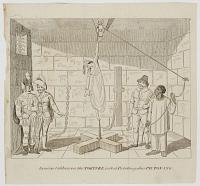
Louisa Caldron on the Torture, called Picketting, alias Picton-ing.
[n.d., c.1806.]
Rare etching. Sheet: 210 x 195mm (8¼ x 7¾"). Trimmed, some damage on left edge and a vertical fold.
A scene showing Luisa Calderón, a young mulatto woman, being tortured to force her confession for helping her lover with a burglary in 1801. The image was used to illustrate the torture used against Calderón in the 1806 trial of the British Governor of Trinidad, General Thomas Picton, who authorised the torture. Picketting, a form of military punishment, was the compelling of a suspended suspect to stand on the flat head of a peg for long periods of time. The trial caused much of a stir with the public, not least because Calderón was attractive and prints such as these showed what a young, attractive woman in state of undress, being tortured might look like captured the public's attention.
[Ref: 41578] £180.00
(£216.00 incl.VAT)
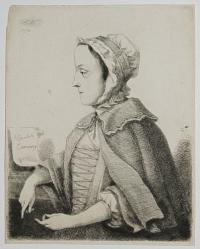
Elizabeth Canning.
TW [Thomas Worlidge] 1754.
Etching. Plate: 190 x 150mm (7½ x 6''). Damage in top left corner.
Elizabeth Canning (1734-1773) in the witness box, portrayed here by Thomas Worlidge, the 'English Rembrandt'. Canning was a London scullerymaid whose alleged kidnapping caused a sensation in 1753. She disappeared for a month before returning to her mother's home. Susannah Wells and Mary Squires, Canning's alleged captors, were tried and found guilty. However, Crisp Gascoyne, trial judge and Lord Mayor of London, was unhappy with the verdict and began his own investigation which led to information proving Squires and her family to be innocent. Several of the prosecution witnesses recanted their earlier testimonies and Canning was tried and found guilty of perjury. She was sentenced to one month's imprisonment and seven years of transportation.
[Ref: 48672] £140.00
(£168.00 incl.VAT)
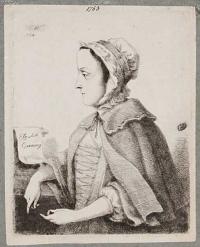
Elizabeth Canning.
TW 1754.
Etching with drypoint, small margins, paper watermarked. Plate 184 x 147mm (7¼ x 5¾"). Slight stain on right; glued to backing sheet at top corners.
Elizabeth Canning (1734-1773) in the witness box, portrayed here by Thomas Worlidge, the 'English Rembrandt'. Canning was a London scullerymaid whose alleged kidnapping caused a sensation in 1753. She disappeared for a month before returning to her mother's home. Susannah Wells and Mary Squires, Canning's alleged captors, were tried and found guilty. However, Crisp Gascoyne, trial judge and Lord Mayor of London, was unhappy with the verdict and began his own investigation which led to information proving Squires and her family to be innocent. Several of the prosecution witnesses recanted their earlier testimonies and Canning was tried and found guilty of perjury. She was sentenced to one month's imprisonment and seven years of transportation.
[Ref: 28956] £180.00
(£216.00 incl.VAT)
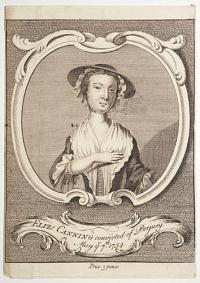
Elizabeth Canning convicted of Perjury. May ye 7th 1754. Price 3 pence.
[n.d. c.1754.]
Engraving. Sheet 175 x 120mm (6¾ x 4¾"). Trimmed. Vertical crease.
Elizabeth Canning (1734-73), an 18-year-old London maidservant, claimed to have been kidnapped on New Year's Day and held for a month in a brothel in Enfield. She accused `Mother Wells', the madam of the establishment, of trying to force her to become a prostitute. A hideous gypsy crone staying in the house, Mary Squires, cut off the girl's stays (worth 10 shillings), and Elizabeth was imprisoned in an attic with only a few crusts of bread and a jug of water to live on. On January 29th she escaped through a window and walked all the way back to her mother's house in the City. Squires and Wells were apprehended, and tried at the Old Bailey; the former was condemned to be hanged, and the latter was burned in the hand and imprisoned. However opinion turned against Canning and new evidence led her to be charged with perjury and transported for seven years. CS 36.ii.
[Ref: 53153] £160.00
(£192.00 incl.VAT)

Elizabeth Canning.
[n.d. c.1755.]
Engraving. Sheet 130 x 100mm (5 x 4"). Trimmed, mounted in album paper.
Elizabeth Canning (1734-73), an 18-year-old London maidservant, claimed to have been kidnapped on New Year's Day 1753 and held for a month in a brothel in Enfield. She accused `Mother Wells', the madam of the establishment, of trying to force her to become a prostitute. A hideous gypsy crone staying in the house, Mary Squires, cut off the girl's stays (worth 10 shillings), and Elizabeth was imprisoned in an attic with only a few crusts of bread and a jug of water to live on. On January 29th she escaped through a window and walked all the way back to her mother's house in the City. Squires and Wells were apprehended, and tried at the Old Bailey; the former was condemned to be hanged, and the latter was burned in the hand and imprisoned. However opinion turned against Canning and new evidence led her to be charged with perjury and transported for seven years.
[Ref: 58657] £120.00
(£144.00 incl.VAT)
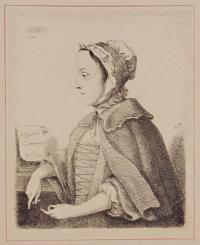
Elizabeth Canning.
TW [Thomas Worlidge] 1754.
Etching, sheet 190 x 150mm (7½ x 6"). Small margins; tipped into album sheet; worn later impression.
Elizabeth Canning (1734-1773) in the witness box, portrayed here by Thomas Worlidge, the 'English Rembrandt'. Canning was a London scullerymaid whose alleged kidnapping caused a sensation in 1753. She disappeared for a month before returning to her mother's home. Susannah Wells and Mary Squires, Canning's alleged captors, were tried and found guilty. However, Crisp Gascoyne, trial judge and Lord Mayor of London, was unhappy with the verdict and began his own investigation which led to information proving Squires and her family to be innocent. Several of the prosecution witnesses recanted their earlier testimonies and Canning was tried and found guilty of perjury. She was sentenced to one month's imprisonment and seven years of transportation. Second state after the number '70' added (in reverse) on the right side. State ii/ii; D41; W69; Ex collection of the Late Hon. C. Lennox-Boyd.
[Ref: 33027] £90.00
(£108.00 incl.VAT)
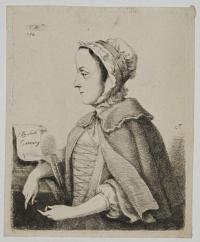
Elizabeth Canning.
TW [Thomas Worlidge] 1754.
Etching, sheet 190 x 150mm (7½ x 6"). Small margins; good impression on laid paper; soiling at top.
Elizabeth Canning (1734-1773) in the witness box, portrayed here by Thomas Worlidge, the 'English Rembrandt'. Canning was a London scullerymaid whose alleged kidnapping caused a sensation in 1753. She disappeared for a month before returning to her mother's home. Susannah Wells and Mary Squires, Canning's alleged captors, were tried and found guilty. However, Crisp Gascoyne, trial judge and Lord Mayor of London, was unhappy with the verdict and began his own investigation which led to information proving Squires and her family to be innocent. Several of the prosecution witnesses recanted their earlier testimonies and Canning was tried and found guilty of perjury. She was sentenced to one month's imprisonment and seven years of transportation. Second state after the number '70' added (in reverse) on the right side. State ii/ii; D41; W69; Ex collection of the Late Hon. C. Lennox-Boyd.
[Ref: 33026] £160.00
(£192.00 incl.VAT)

Elizabeth Canning.
TW [Thomas Worlidge] 1754.
Etching, sheet 190 x 150mm (7½ x 6"). Trimmed on platemark; good impression on laid paper; glued to backing sheet at corners.
Elizabeth Canning (1734-1773) in the witness box, portrayed here by Thomas Worlidge, the 'English Rembrandt'. Canning was a London scullerymaid whose alleged kidnapping caused a sensation in 1753. She disappeared for a month before returning to her mother's home. Susannah Wells and Mary Squires, Canning's alleged captors, were tried and found guilty. However, Crisp Gascoyne, trial judge and Lord Mayor of London, was unhappy with the verdict and began his own investigation which led to information proving Squires and her family to be innocent. Several of the prosecution witnesses recanted their earlier testimonies and Canning was tried and found guilty of perjury. She was sentenced to one month's imprisonment and seven years of transportation. First state before the number '70' added on the right side. State i/ii; D41; W69; Ex collection of the Late Hon. C. Lennox-Boyd.
[Ref: 33025] £140.00
(£168.00 incl.VAT)
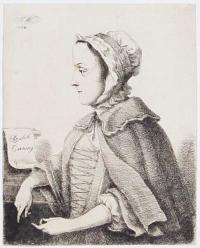
Elizabeth Canning.
TW [Thomas Worlidge] 1754.
Etching, sheet 190 x 150mm (7½ x 6"). Trimmed on platemark; good impression on laid paper.
Elizabeth Canning (1734-1773) in the witness box, portrayed here by Thomas Worlidge, the 'English Rembrandt'. Canning was a London scullerymaid whose alleged kidnapping caused a sensation in 1753. She disappeared for a month before returning to her mother's home. Susannah Wells and Mary Squires, Canning's alleged captors, were tried and found guilty. However, Crisp Gascoyne, trial judge and Lord Mayor of London, was unhappy with the verdict and began his own investigation which led to information proving Squires and her family to be innocent. Several of the prosecution witnesses recanted their earlier testimonies and Canning was tried and found guilty of perjury. She was sentenced to one month's imprisonment and seven years of transportation. First state before the number '70' added on the right side. State i/ii; D41; W69; Ex collection of the Late Hon. C. Lennox-Boyd.
[Ref: 33024] £140.00
(£168.00 incl.VAT)

Mr. Bampfylde Moore Carew, King of the Beggars.
[n.d. c.1770].
Engraving. Sheet 280 x 215mm. Trimmed inside plate mark.
Bampfylde Moore Carew [1693 - 1759] was a rogue and imposter, who claimed to be King of the Beggars. Little is known about him other than what is in his memoirs 'The Life and Adventures of Bampfylde Moore Carew', first published 1745.
[Ref: 154] £180.00
(£216.00 incl.VAT)
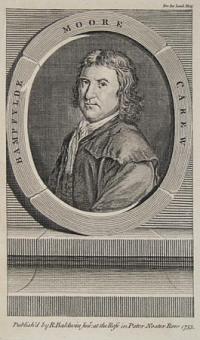
Bampfylde Moore Carew.
For the Lond. Mag.
Publish'd by R. Baldwin Junr: at the Rose in Pater Noster Row 1753.
Engraving, 195 x 120mm.
'King of the Beggars', adventurer (1693 - 1759). Copied from the mezzotint after Phelps. At the age of twelve he was sent to Tiverton school, where for some time he worked hard, but the schoolboys possessed among them a pack of hounds, and one day he, with three companions, followed a deer so far, that the neighbouring farmers came to complain of the damage done. To avoid punishment the youths ran away and joined some gipsies. After a year and a half Carew returned for a time, but soon rejoined the gipsies. His career was a long series of swindling and imposture, very ingeniously carried out, occasionally deceiving people who should have known him well. His restless nature then drove him to embark for Newfoundland, where he stopped but a short time, and on his return he pretended to be the mate of a vessel, and eloped with the daughter of a respectable apothecary of Newcastle-on-Tyne, whom he afterwards married. He continued his course of vagabond roguery for some time, and when Clause Patch, a king, or chief of the gipsies, died, Carew was elected his successor. He was convicted of being an idle vagrant, and sentenced to be transported to Maryland. On his arrival he attempted to escape, was captured, and made to wear a heavy iron collar, escaped again, and fell into the hands of some friendly Indians, who relieved him of his collar. He took an early opportunity of leaving his new friends, and got into Pennsylvania. Here he pretended to be a quaker, and as such made his way to Philadelphia, thence to New York, and afterwards to New London, where he embarked for England. He escaped impressment on board a man-of-war by pricking his hands and face, and rubbing in bay salt and gunpowder, so as to simulate small-pox. After his landing he continued his impostures, found out his wife and daughter, and seems to have wandered into Scotland about 1745, and is said to have accompanied the Pretender to Carlisle and Derby. BM: pg.337, 4.
[Ref: 7462] £45.00
(£54.00 incl.VAT)
![[Mary Carleton] The German Princess with her suppos'd Husband and Lawyer.]](img-thumbnail/jpegs/56657.jpg)
[Mary Carleton] The German Princess with her suppos'd Husband and Lawyer.]
J. Nicholls delin. I. Basire sculp.
[n.d., c.1740.]
Engraving. Sheet 315 x 205mm (12½ x 8"). Trimmed within plate.
Mary Carleton (neé Moders, 1642-73), bigamist and fraudster who often pretended to be a German princess (having lived in Cologne) or an heiress. Having defrauded many men over more than ten years, she was convicted and hanged. This scene shows her with a different con: having attracted a rich lawyer as a lover, her 'husband' bursts in with an armed servant and extorts £100 from the lawyer. Probably from 'History of the Lives of the Most Notorious Highwaymen' by Captain Alexander Smith (pseud.), although examples of this print were issued as a broadside with letterpress. See National Portrait Gallery: NPG D21077 for separate issue.
[Ref: 56657] £95.00
(£114.00 incl.VAT)
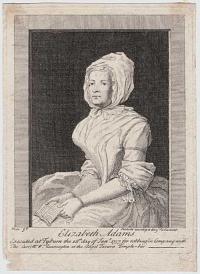
Elizabeth Adams. Executed at Tyburn the 18th day of Jan.y 1737 for robbing (in Company with Tho.s Carr) Mr W.m Quarrington in the Angel Tavern Temple-bar.
Publish'd according to Act of Parliament [n.d., c.1737].
Rare engraving. Sheet 200 x 150mm (8 x 6"). Creased. Small margins.
Elizabeth Adams and her partner, Thomas Carr (the vestry clerk of the parish of St Paul, Covent Garden) stole ninety-three guineas and a diamond ring from William Quarrington. At Tyburn the pair kissed and held hands as the cart moved away from under their feet. See Item 53146 for the matching portrait of Thomas Carr.
[Ref: 62246] £160.00
(£192.00 incl.VAT)
![[Louis Dominique Garthausen] Le Veritable Portrait de Cartouche tiré d'aprés Nature étant dans les Cachot.](img-thumbnail/jpegs/56600.jpg)
[Louis Dominique Garthausen] Le Veritable Portrait de Cartouche tiré d'aprés Nature étant dans les Cachot.
[n.d., c.1725.]
Rare copper engraving, 255 x 330mm (10 x 13 ") Trimmed to plate on 2 sides. Small margins on left & right.
Louis Dominique Garthausen (1693-1721), better known as Cartouche, shown chained in his cell after an escape attempt. He was the leader of a band of over 2000 brigands (many ex-soldiers) operating in and around Paris during the regency of Philippe d'Orléans. A Robin Hood character, his exploits (including stealing 1.3 million livres of shares in John Law's Mississippi Company) and seductions made him a folk hero. The authorities resorted to torturing known associates for information, eventually getting a member of the band to betray him. Cartouche was arrested, tortured to no avail, then broken on the wheel.
[Ref: 56600] £260.00
(£312.00 incl.VAT)
![[Louis Dominique Garthausen] Le Veritable Portrait de Cartouche.](img-thumbnail/jpegs/56601.jpg)
[Louis Dominique Garthausen] Le Veritable Portrait de Cartouche.
[n.d., c.1721.]
Rare engraving with etching. Sheet 230 x 175mm (9 x 7"). Trimmed into image on three sides and into title at bottom, losing four lines of text.
Louis Dominique Garthausen (1693-1721), better known as Cartouche, shown with his hand on his sword hilt, a deep scar on his left cheek. Cartouche was the leader of a band of over 2000 brigands (many ex-soldiers) operating in and around Paris during the regency of Philippe d'Orléans. A Robin Hood character, his exploits (including stealing 1.3 million livres of shares in John Law's Mississippi Company) and seductions made him a folk hero. The authorities resorted to torturing known associates for information, eventually getting a member of the band to betray him. Cartouche was arrested, tortured to no avail, then broken on the wheel. The original text under this image describes his arrest but not his execution. BM 1877,0811.1011.
[Ref: 56601] £260.00
(£312.00 incl.VAT)
![Richard Tidd. [&] William Davidson. [&] Thomas Brunt. [&] James Ings. [&]](img-thumbnail/jpegs/44441.jpg)
Richard Tidd. [&] William Davidson. [&] Thomas Brunt. [&] James Ings. [&] Thomas Hiden. [&] Robert Adams. [&] John Monument. [&] Arthur Thistlewood.
[Engraved by Robert Cooper after Abrham Wivell.
[London, Published by Thos. Kelly, 17 Paternoster Row, May 2 1820.]
Eight stipple-engraved portrait scraps. Largest sheet c. 110 x 85mm (4¼ x 3¼"). Trimmed from larger sheets, mounted on album paper, Thistlewood with old ink mss.
Portraits of the Cato Street Conspirators from a book, 'The Cato Street Conspiracy', published the day after. Thistlewood, Davidson, Ings, Tidd and Brunt were executed at Newgate Prison, 1820.
[Ref: 44441] £160.00
(£192.00 incl.VAT)
view all images for this item
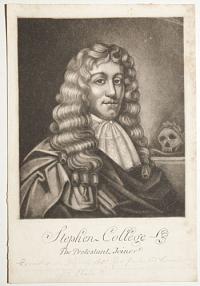
Stephen College. The Protestant Joiner.
[n.d., engraved c.1670, printed c.1820.]
Mezzotint. Sheet 190 x 125mm (7½ x 5"). Slight foxing. Trimmed within plate on three sides.
A portrait of Stephen College (also Colledge, c.1635-81), with a skull in the background. A joiner by trade, he aided the fabricated Popish Plot by writing ballads and polemics against catholics and lawyers. He was tried and executed for high treason in Oxford in 1681.
[Ref: 53147] £80.00
(£96.00 incl.VAT)
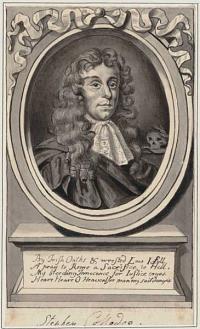
Stephen College.
[n.d., c.1800.]
Ink and wash. Sheet 170 x 100mm (6¾ x 4"). Mounted in album paper at edges.
A portrait of Stephen College (also Colledge, c.1635-81), with a skull in the background. A joiner by trade, he aided the fabricated Popish Plot by writing ballads and polemics against catholics and lawyers. He was tried and executed for high treason in Oxford in 1681. An adapted copy of a contemporary mezzotint.
[Ref: 62113] £180.00
(£216.00 incl.VAT)

The Convicts taking Water near Black Friars Bridge, in order for their being conveyed to Woolwich.
Dodd delin. Pollard sculp.
Engraving, 190 x 120mm (7½ x 4¾"), with very large margins.
A view of the convicts being loaded onto the hulks in the Thames. Prisoners were often kept in hulks while they awaited deportation; often to Australia. Australian transportation image.
[Ref: 60595] £280.00
(£336.00 incl.VAT)

View of the Justitia Hulk, with the Convicts at Work, near Woolwich. New Newgate Calendar or Malefactor's Register.
Dodd delin. Page sc.
Engraving, 190 x 120mm (7½ x 4¾"), with large margins. Right margin stained.
A view of the Justitia Hulk in the Thames which was used to house convicts. Prisoners were often kept in hulks while they awaited deportation; often to Australia. Australian transportation image.
[Ref: 60594] £280.00
(£336.00 incl.VAT)

James Cook the Murderer of Mr Paas at Leicester. Vivant.
W. Wadsworth 7 Vinegar Yard, Dury Lane.
Etching. Sheet 265 x 165mm (10½ x 6½"). Trimmed within plate, notched in top left edge.
A full-length portrait of murderer James Cook (1811-32), standing looking down with a horrified expression, holding a hat with both hands, wearing short open double-breasted jacket, waistcoat and neckerchief tied in a bow. Cook, a 21-year old bookbinder, owed John Pass (originally Paas), an engraver and bookbinders' toolmaker, money. When Pass called to collect, Cook killed him and attempted to hide the crime by dismembering Pass and trying to burn the limbs. Cook was hung and gibbetted in Leicester: so many visitors came to view the body that the Home Office intervened, ordering it removed. This was the last recorded gibbeting in England.
[Ref: 62110] £140.00
(£168.00 incl.VAT)
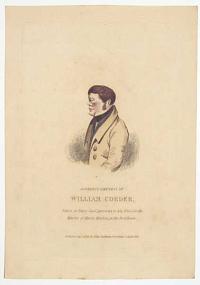
A Correct Likeness of William Corder, Taken in Bury Gaol, previous to his Trial for the Murder of Maria Marten, in the Red Barn.
Published Aug.t 4, 1828, by John Fairburn, Broadway, Ludgate Hill.
Scarce etching with hand colour, plate 230 x 150mm (9 x 6"), large margins. Some very light foxing and surface dirt.
William Corder (1803-28), the Red Barn murderer. Corder, a fraudster and ladies' man, made a rendezvous with his girlfriend Maria Marten at the barn (which is shown here below the portrait) on the pretext of eloping. Instead he killed her, stuffed her body in a sack and buried her. Corder disappeared and wrote home pretending the two were together, but Marten's body was discovered and a hunt for Corder started. He was, arrested, tried, and sentenced to be hung and dissected. The hanging attracted a huge crowd; the dissection was performed before an audience of Cambridge students. A battery was connected to his limbs to demonstrate muscle contraction; Corder's skin was tanned by the surgeon George Creed and used to bind an account of the murder; and his skeleton was put on display in the Hunterian Museum in the Royal College of Surgeons.
[Ref: 58993] £260.00
(£312.00 incl.VAT)
![W.m Corder [facsimile signature]. Red Barn.](img-thumbnail/jpegs/58776.jpg)
W.m Corder [facsimile signature]. Red Barn.
[n.d., c.1828.]
Wood engraving. Sheet 170 x 110mm (6¾ x 4¼").
William Corder (1803-28), convicted for the 'Red Barn Murder' of 1827. Corder, a fraudster and ladies' man, made a rendezvous with his girlfriend Maria Marten at the barn on the pretext of eloping. Instead he killed her, stuffed her body in a sack and buried her. Corder disappeared but wrote home pretending the two were together, but her body was discovered and a hunt for Corder started. He was discovered, arrested, tried and convicted, and sentenced to be hung and dissected. The hanging attracted a huge crowd; the dissection was performed before an audience of Cambridge students. A battery was connected to his limbs to demostrate muscle contraction; Corder's skin was tanned by the surgeon George Creed and used to bind an account of the murder; and his skeleton was put on display in the Hunterian Museum in the Royal College of Surgeons
[Ref: 58776] £85.00
(£102.00 incl.VAT)
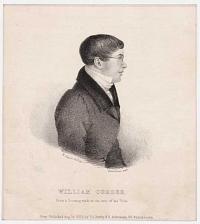
William Corder. From a Drawing Made at the Time of his Trial.
M. Gauci lithog. Rackstraw del.t.
Bury: Published Aug. 16, 1828, by T.C. Newby, & R. Ackermann, 96 Strand, London.
Rare lithograph. Sheet 150 x 135mm (6 x 5¼"). Slight time staining.
William Corder (1803-28), convicted for the 'Red Barn Murder' of 1827. Corder, a fraudster and ladies' man, made a rendezvous with his girlfriend Maria Marten at the barn on the pretext of eloping. Instead he killed her, stuffed her body in a sack and buried her. Corder disappeared but wrote home pretending the two were together, but her body was discovered and a hunt for Corder started. He was discovered, arrested, tried and convicted, and sentenced to be hung and dissected. The hanging attracted a huge crowd; the dissection was performed before an audience of Cambridge students. A battery was connected to his limbs to demostrate muscle contraction; Corder's skin was tanned by the surgeon George Creed and used to bind an account of the murder; and his skeleton was put on display in the Hunterian Museum in the Royal College of Surgeons.
[Ref: 62411] £130.00
(£156.00 incl.VAT)
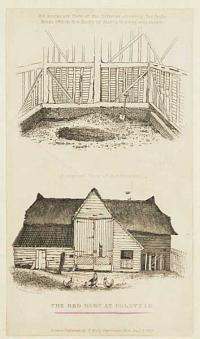
The Red Barn at Polstead An accurate View of the Interior, showing the hole from which the Body of Maria Marten was taken. A correct View of the Exterior.
W. Panormo del et sculp
London, Published by T. Kelly, Paternoster Row, Aug.t 2. 1828.
Engraving, sheet 210 x 120mm (8¼ x 4¾"). Glued to backing sheet at top corners.
The notorious 'Red Barn' in Polstead, Suffolk, the scene of an infamous murder committed by William Corder in 1827. Corder (1803-28), a fraudster and ladies' man, made a rendezvous with his girlfriend Maria Marten at the barn on the pretext of eloping. Instead he killed her, stuffed her body in a sack and buried her. Corder disappeared and wrote home pretending the two were together, but Marten's body was discovered and a hunt for Corder started. He was, arrested, tried, and sentenced to be hung and dissected. The hanging attracted a huge crowd; the dissection was performed before an audience of Cambridge students. A battery was connected to his limbs to demonstrate muscle contraction; Corder's skin was tanned by the surgeon George Creed and used to bind an account of the murder; and his skeleton was put on display in the Hunterian Museum in the Royal College of Surgeons.
[Ref: 39214] £90.00
(£108.00 incl.VAT)
![[John Cottington] Mulld . Sake.](img-thumbnail/jpegs/54307.jpg)
[John Cottington] Mulld . Sake. I Walke the Strand, and Westminster; and Scorne / to march t'th Cittie; though I beare the Horne, / My feather, and my yellow Band, accord / to prove me Courtier, My Boote, spur, and sword, / My smokinge Pipe, Scarfe, Garter, Rose on Shoe, / Showe my brave mind, t'affect what Gallants do. / I Singe, dance, drinke, and merrily passe the day, / and like a Chimney, sweep all care away.
Pub.d Aug.t 8th 1794 by Caulfield and Herbert.
Etching with engraving. Sheet 245 165mm (9½ x 6½"). Trimmed within plate.
Full length portrait of John Cottington (1610-1655), called 'Mul-Sack', a chimney sweep, carrying the tools of his trade. However, after a bad marriage (his bride turned out to be a cross-dresser), he turned to crime: becoming a pickpocket, he is said to have attempted to steal Oliver Cromwell's purse. After a failed attempt at highway robbery he fled to the contintent, where he was introduced at the court of exiled Charles II. Assuming he had enough intelligence to buy a pardon from Oliver Cromwell, he returned to England, but he was arrested and executed in Smithfield Rounds in April, 1655. From James Caulfield's 'Portraits, Memoirs, and Characters of remarkable Persons, from the Reign of Edward III to the Revolution'.
[Ref: 54307] £45.00
(£54.00 incl.VAT)







![[Rachel Belaney] The Wife of J.C. Belany, of North Sunderland.](img-thumbnail/jpegs/62116.jpg)

![[John Bellingham?]](img-thumbnail/jpegs/47884.jpg)
![[Joseph Blake, highwayman] Blake, alias Blueskin, attempting to cut the Throat of Jonathan Wild,](img-thumbnail/jpegs/62100.jpg)



![[Thomas Blood] Coll' Blood.](img-thumbnail/jpegs/62420.jpg)


![[Forger] The Celebrated James Bolland.](img-thumbnail/jpegs/62103.jpg)
![[Mode of punishment by Branding, or burning of the Hand, at the New Sessions House.]](img-thumbnail/jpegs/62101.jpg)
















![[Mary Carleton] The German Princess with her suppos'd Husband and Lawyer.]](img-thumbnail/jpegs/56657.jpg)

![[Louis Dominique Garthausen] Le Veritable Portrait de Cartouche tiré d'aprés Nature étant dans les Cachot.](img-thumbnail/jpegs/56600.jpg)
![[Louis Dominique Garthausen] Le Veritable Portrait de Cartouche.](img-thumbnail/jpegs/56601.jpg)
![Richard Tidd. [&] William Davidson. [&] Thomas Brunt. [&] James Ings. [&]](img-thumbnail/jpegs/44441.jpg)






![W.m Corder [facsimile signature]. Red Barn.](img-thumbnail/jpegs/58776.jpg)


![[John Cottington] Mulld . Sake.](img-thumbnail/jpegs/54307.jpg)